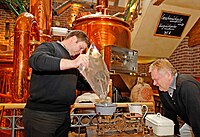Beer chemistry

Alright kiddo, let's talk about beer chemistry!
First of all, do you know what beer is? It's a drink made from water, grains (like barley), and hops. Sometimes people also add yeast to help the beer ferment, which means that the sugar in the grains turns into alcohol.
Now, let's talk about the chemistry behind beer. Do you remember what atoms are? They're the building blocks of everything around us! Beer is made up of lots of different atoms, but three of the most important ones are carbon, hydrogen, and oxygen.
When these atoms combine in different ways, they create molecules. And the molecules in beer are what give it its flavor and aroma. For example, hops contain molecules called alpha acids that give beer its bitterness. And certain types of grains contain molecules called esters that give beer its fruity taste.
But the chemistry of beer isn't just about flavor. It's also about the process of brewing. When brewers heat up the grain and water mixture (called the mash), it creates a chemical reaction called the Maillard reaction. This is what gives beer its dark color and rich flavor.
And finally, let's talk about alcohol. Alcohol is created during the fermentation process, when yeast consumes the sugars in the grain and turns them into alcohol and carbon dioxide gas. But too much alcohol can be dangerous, so it's important to drink beer responsibly.
So there you have it, a little explanation of beer chemistry! Just remember, beer is made up of lots of tiny atoms and molecules, and the way they combine together is what gives beer its unique flavor and aroma.
First of all, do you know what beer is? It's a drink made from water, grains (like barley), and hops. Sometimes people also add yeast to help the beer ferment, which means that the sugar in the grains turns into alcohol.
Now, let's talk about the chemistry behind beer. Do you remember what atoms are? They're the building blocks of everything around us! Beer is made up of lots of different atoms, but three of the most important ones are carbon, hydrogen, and oxygen.
When these atoms combine in different ways, they create molecules. And the molecules in beer are what give it its flavor and aroma. For example, hops contain molecules called alpha acids that give beer its bitterness. And certain types of grains contain molecules called esters that give beer its fruity taste.
But the chemistry of beer isn't just about flavor. It's also about the process of brewing. When brewers heat up the grain and water mixture (called the mash), it creates a chemical reaction called the Maillard reaction. This is what gives beer its dark color and rich flavor.
And finally, let's talk about alcohol. Alcohol is created during the fermentation process, when yeast consumes the sugars in the grain and turns them into alcohol and carbon dioxide gas. But too much alcohol can be dangerous, so it's important to drink beer responsibly.
So there you have it, a little explanation of beer chemistry! Just remember, beer is made up of lots of tiny atoms and molecules, and the way they combine together is what gives beer its unique flavor and aroma.
Related topics others have asked about:
